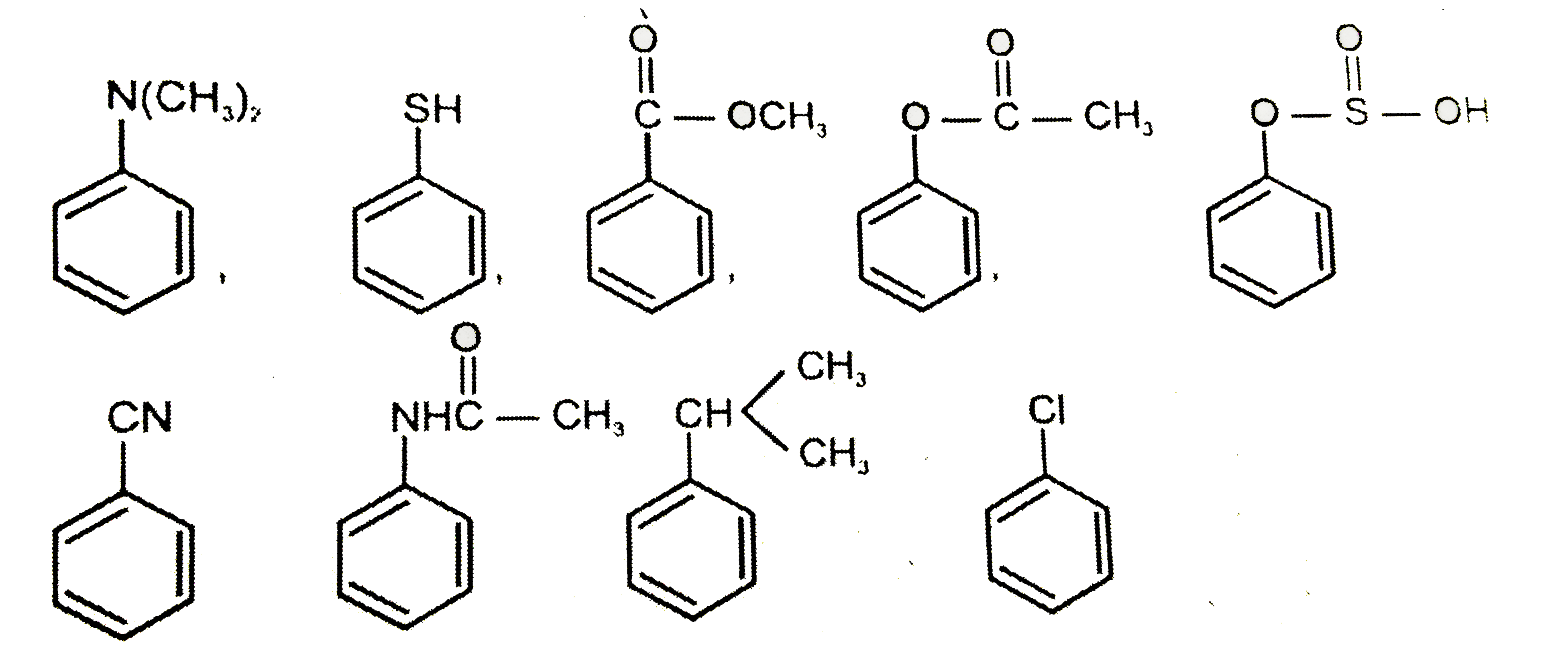Which of the following groups exerts +m effect when attached with benzene ring?
−⊕S(CH3)2group
−⊕N(CH3)3group
−OCH3group
−NHCH3group
The correct Answer is:C, D
To determine which of the given groups exerts a +M (mesomeric) effect when attached to a benzene ring, we need to analyze each option based on the presence of lone pairs of electrons and their ability to donate electron density to the benzene ring. The +M effect increases the electron density at the ortho and para positions of the benzene ring.
1. Understanding +M Effect:
- The +M effect refers to the mesomeric effect, where groups with lone pairs of electrons can donate electron density to the benzene ring, enhancing its reactivity at the ortho and para positions.
2. Analyzing Option A:
- The first option contains a sulfur atom with a positive charge (S^+).
- Since sulfur has a positive charge, it means that its lone pair of electrons has already been donated, and thus it cannot donate any more electron density to the benzene ring.
- Conclusion: Option A does not exert a +M effect.
3. Analyzing Option B:
- The second option features a nitrogen atom (N) with a positive charge (N^+).
- Similar to sulfur in Option A, the nitrogen with a positive charge does not have a lone pair available to donate to the benzene ring.
- Conclusion: Option B does not exert a +M effect.
4. Analyzing Option C:
- The third option is OCH3 (methoxy group).
- Oxygen has a lone pair of electrons that can be donated to the benzene ring. This donation increases the electron density at the ortho and para positions.
- Conclusion: Option C exerts a +M effect.
5. Analyzing Option D:
- The fourth option is NHCH3 (aniline derivative).
- The nitrogen atom in this group has a lone pair of electrons that can also be donated to the benzene ring, enhancing the electron density at the ortho and para positions.
- Conclusion: Option D exerts a +M effect.
6. Final Result:
- The groups that exert a +M effect when attached to the benzene ring are Option C (OCH3) and Option D (NHCH3).
- The +M effect refers to the mesomeric effect, where groups with lone pairs of electrons can donate electron density to the benzene ring, enhancing its reactivity at the ortho and para positions.
- The first option contains a sulfur atom with a positive charge (S^+).
- Since sulfur has a positive charge, it means that its lone pair of electrons has already been donated, and thus it cannot donate any more electron density to the benzene ring.
- Conclusion: Option A does not exert a +M effect.
- The second option features a nitrogen atom (N) with a positive charge (N^+).
- Similar to sulfur in Option A, the nitrogen with a positive charge does not have a lone pair available to donate to the benzene ring.
- Conclusion: Option B does not exert a +M effect.
- The third option is OCH3 (methoxy group).
- Oxygen has a lone pair of electrons that can be donated to the benzene ring. This donation increases the electron density at the ortho and para positions.
- Conclusion: Option C exerts a +M effect.
- The fourth option is NHCH3 (aniline derivative).
- The nitrogen atom in this group has a lone pair of electrons that can also be donated to the benzene ring, enhancing the electron density at the ortho and para positions.
- Conclusion: Option D exerts a +M effect.
- The groups that exert a +M effect when attached to the benzene ring are Option C (OCH3) and Option D (NHCH3).
Topper's Solved these Questions
- BOOK - RESONANCE ENGLISHCHAPTER - TEST PAPERSEXERCISE - Chemistry701videos
TEST PAPERS
- BOOK - RESONANCE ENGLISHCHAPTER - TEST PAPERSEXERCISE - PT-0130videos
TEST PAPERS
- BOOK - RESONANCE ENGLISHCHAPTER - TEST PAPERSEXERCISE - PART - III CHEMISTRY46videos
TEST PAPERS
- BOOK - RESONANCE ENGLISHCHAPTER - SURFACE CHEMISTRYEXERCISE - Section - 51videos
SURFACE CHEMISTRY
- BOOK - RESONANCE ENGLISHCHAPTER - TEST SERIESEXERCISE - CHEMISTRY50videos
TEST SERIES
Similar Questions
Knowledge Check
- Question 1 - Select One
Which of the following groups is o-p directing but deactivates benzene ring for electrophilic substitution?
A−CH3B−NH2C−ClD−NO2
Which of the following group show +M and −l effect?
View SolutionWhich of the following group show −m and −I effect?
View SolutionWhich of the following set of groups can show +R effect?
View SolutionWhich of the following set of groups can show +Reffect?
View SolutionWhich of the following group (s) is/are m-directing ?
View SolutionWhich of the following groups (attached with benzene ring ) show +M effect ?
 View Solution
View SolutionWhich of the following is strongest −m group
View Solution

